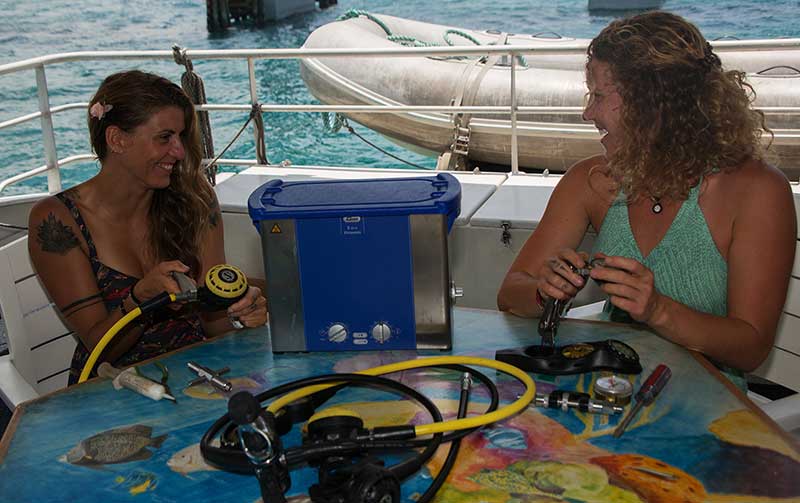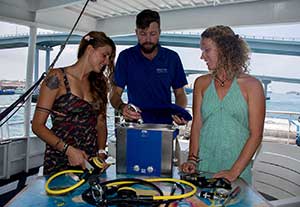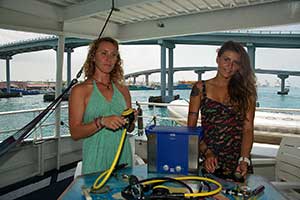
Ultrasonic Cleaners for Scuba Gear Maintenance
Perfectly functioning valves and regulators are essential for reliable air supply to scuba diving enthusiasts. Fresh water rinsing scuba regulators after each dive is part of the ritual; ultrasonic cleaning of disassembled regulator components should be a part of any organization renting gear or offering scuba diving excursions.
A good example is Florida based All Star Liveaboards, offering scuba diving enthusiasts “the best in liveaboard scuba diving and snorkeling in the Caribbean.” Living aboard the Aqua Cat or other company vessels participants enjoy week long cruises from Nassau, Bahamas, to the islands of the Exuma Sound. Participants include experienced divers with their own or All Star’s rental gear and novices wishing to learn the sport from All Star’s certified on-board scuba instructors.
An Ultrasonic Cleaning Program for Scuba Gear

All Star Liveaboard’s Gerry Fleming is the go-to guy when it comes to maintenance programs for the company’s scuba diving rental equipment. “We’ve been in business for 36 years and have a lot of hands-on experience about what works best to clean and maintain costly scuba regulators and tank pressure valves. A key component of our maintenance program is an Elma E60H ultrasonic cleaner we purchased through Tovatech.”
Ultrasonic cleaning differs radically from manual soaking and scrubbing. Cleaning is accomplished by microscopic vacuum bubbles that implode, not explode, on contact with all surfaces immersed in an ultrasonic leaning solution. The solution is in a tank to which are bonded generator-powered transducers vibrating at frequencies such as 37,000 cycles per second (37 kHz). This process, called ultrasonic cavitation, blasts loose and carries away contaminants such as salt, sand and other residues adhering to precisely functioning air pressure regulators scuba divers rely on. The unit’s permanent “sweep” mode provides uniform cleaning action throughout the bath.
All Star’s Ultrasonic Scuba Gear Cleaning Cycle
“Ultrasonic cleaning is ideal because it is thorough and because it is safe for scuba components that can be safely immersed in a liquid,” says Gerry. “That,” he adds with a smile, “includes anything scuba divers use.”
A mildly acidic cleaning solution such as elma tec clean S1 with a pH of 1.6 in concentrate form and a recommended dilution of to 1 to 5% with water can be used. It removes corrosion and lime deposits, water damage, grease, oil and oxide layers from non-ferrous and light metals, plastics, brass and copper.
The solution is prepared by filling the tank half way with water, adding the correct amount of cleaning solution concentrate for a full tank then adding water to the fill line.
Prepare the solution by turning the unit on for mixing and driving off trapped air that inhibits cavitation action. After about 10 minutes (depending on the cleaning tank capacity) the solution is ready.
On a regular cycle All Star’s rental scuba regulators are completely disassembled. Air hoses are plugged to avoid cleaning solution ingress.
Disassembled regulator components and hoses are placed in a mesh basket in such a way that they do not contact each other. Basket are lowered into the solution and the ultrasound is activated. When the unit is operating the ultrasonic activity is perceptible as a hissing sound in the tank and moving waves on the surface. At the end of the cleaning cycle the scuba equipment is rinsed in fresh water to wash away cleaning solution residue then allowed dry for reassembly by the All Star diving crew.
According to Gerry a typical cycle for ultrasonic cleaning scuba regulator assemblies at All Star is 15 seconds. Depth gauges, compasses, timers and similar diving gear are also cleaned on a regular basis.
Cleaning On-Board Scuba Tank Air Compressor Components

Week-long dive cruises call for All Star to refill its leased air tanks using on-board compressors. “Compressor valves and piping can accumulate residues that we don’t want to introduce into our tanks,” Gerry explains. “On a programmed basis we ultrasonically clean these valves by immersing them in L6 Gun Cleaning solution. When diluted to 10% with water this solution quickly removes carbon, oil, grease, dirt and other contaminants that otherwise could enter the divers’ air tanks.”
Ultrasonic Cleaning Tips
All Star Liveaboards‘ successful experience using ultrasonic cleaners to help ensure the reliable operation of their leased equipment is a good example of how this technology works. Regardless of what is being cleaned using ultrasonic cavitation there are steps that should be followed:
- Follow the manufacturer’s instructions in operating the ultrasonic cleaner.
- Dilute the cleaning concentrate according to manufacturers’ recommendations.
- Fill the tank to the correct level. Under filling can damage the tank; overfilling will decrease the efficiency of the ultrasonic cleaning process.
- Covering the tank will help avoid solution evaporation and will reduce noise.
- Do not reach into an operating cleaning bath. It can result in burns. If you must reposition scuba equipment parts remove the basket to do so then replace it.
- When the cleaning solution becomes discolored and cleaning time increases the solution should be disposed of properly and replaced, repeating the degassing step.
Consult the ultrasonic experts at Tovatech for help in selecting the ultrasonic cleaner size and process that help you get the best return on your investment.
